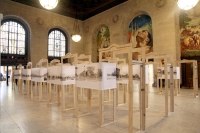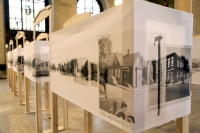Black Bottom Street View Exhibit
Detroit Public Library, Mich.
Innovation Synopsis
Curator Emily Kutil used photographs from the Library Historical Collection that documented Detroit’s former Black Bottom neighborhood before it was razed for urban renewal and development in the 1950s. Digitally stitching the photographs together to create long continuous panoramas visually recreated Black Bottom, street by street, block by block.
Challenge/Opportunity
Black Bottom was home to a rich and vibrant community that became the center of African American life in the city. The exhibit allowed patrons to discover this former neighborhood of Detroit, connecting current efforts of revitalization and renewal with the past. Most importantly, it highlighted archival and photographic collections that are housed in the library, illustrating how history can be relevant and engaging — and encouraged further research and exploration among the visitors.
Key Elements of Innovation
Utilizing the large Strohm Hall on the third floor of the library, Emily Kutil created an immersive experience for viewers to virtually “walk” along the streets and up and down the blocks of the former Black Bottom. The exhibit became an historical “Google Street View” that allowed patrons to see the city and its history in a different way. The exhibit created an opportunity for lectures, tours and, most importantly, discussions to share both family and community history.
Achieved Outcomes
The exhibit exceeded expectations in regards to the dialogue, word-of-mouth buzz and media interest it created, including local newspapers and T.V. news reporting for African American History Month. A steady stream of visitors resulted in extending the exhibit to five months, illustrating the community interest and excitement about these types of exhibits, programs and events. For many viewers, it was their first trip to the library. For others, it was an opportunity to rediscover the wealth of history and collections.


